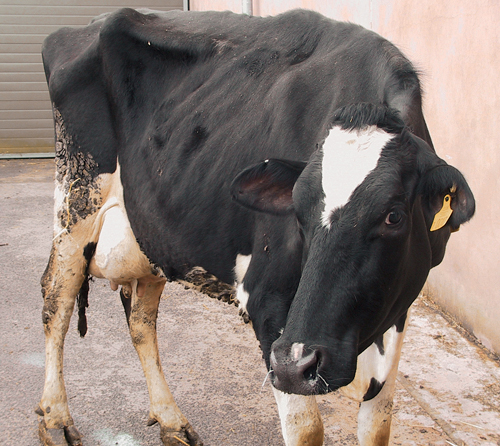Difference between revisions of "Cattle Medicine Q&A 01"
| Line 33: | Line 33: | ||
|q4=How could this condition be prevented? | |q4=How could this condition be prevented? | ||
|a4= | |a4= | ||
| − | Control measures include feeding molasses-treated chopped straw as part of the | + | Control measures include feeding molasses-treated chopped straw<ref>Feeding molasses is generally frowned upon during the dry period due to the high potassium content which can increase the rate of milk fever in the herd.</ref> as part of the ration during the dry period to maintain rumen size and microbial function. Dry matter intakes should be as high as possible during the dry period, and on the day of calving in particular. There must be 24 hr of easy access to the diet – one should not rely on feeding refusals from the milking herd ration to the dry cows. Any dietary changes must be introduced gradually. Most high-yielding cows are fed a total mixed ration which has the benefit of creating a more stable rumen environ - ment than that achieved with separate concentrate feeding. Cows should enter the dry period in BCS 3 (scale 1–5) and maintain that value until calving. |
| − | ration during the dry period to maintain rumen size and microbial function. Dry | ||
| − | matter intakes should be as high as possible during the dry period, and on the day | ||
| − | of calving in particular. There must be 24 hr of easy access to the diet – one should | ||
| − | not rely on feeding refusals from the milking herd ration to the dry cows. Any | ||
| − | dietary changes must be introduced gradually. Most high-yielding cows are fed a | ||
| − | total mixed ration which has the benefit of creating a more stable rumen environ - | ||
| − | ment than that achieved with separate concentrate feeding. Cows should enter the | ||
| − | dry period in BCS 3 (scale 1–5) and maintain that value until calving. | ||
|l4=Ketosis of Cattle#Prevention and Control | |l4=Ketosis of Cattle#Prevention and Control | ||
</FlashCard> | </FlashCard> | ||
| + | |||
| + | {{Comments | ||
| + | |by = Nick Lyons MA VetMB CertCHP MRCVS | ||
| + | }} | ||
{{#tag:imagemap|Image:Next Question.png{{!}}center{{!}}200px | {{#tag:imagemap|Image:Next Question.png{{!}}center{{!}}200px | ||
Revision as of 15:15, 2 September 2011
| This question was provided by Manson Publishing as part of the OVAL Project. See more Cattle questions |
A 5-year-old Holstein cow, which calved 1 month ago and was previously yielding 42 L/day, presents with a poor appetite and milk yield which has fallen steadily over the past 2 days to 22 L/day. The cow has been licking at objects such as walls and her own flanks for long periods of time. The rectal temperature is normal. The cow has a gaunt appearance with sunken sublumbar fossae consistent with a reduced appetite. The cow is constipated while other cows in the high-yielding group have soft faeces.
| Question | Answer | Article | |
| What conditions would you consider? (Most likely first.) | The most likely conditions to consider include: nervous acetonaemia/ketosis; left-displaced abomasum and secondary acetonaemia; traumatic reticulitis; sub - acute ruminal acidosis. |
Link to Article | |
| How could you confirm your diagnosis? | Diagnosis of ketosis is based on clinical examination and confirmed by a positive Rothera’s reagent test or laboratory demonstration of a 3-OH butyrate concentration in excess of 4.0 mmol/L (40 mg/dL). Plasma glucose and NEFA concentrations are too variable to confirm a diagnosis of ketosis. No biochemical test differentiates between primary and secondary ketosis. It must be ascertained that the cow does not have a left-displaced abomasum. |
Link to Article | |
| What treatment would you administer? | Treatment includes dexamethasone and 400mL 50% dextrose administered intravenously. Propylene glycol is given orally twice daily until normal appetite returns. The cow was eating well the following day. |
Link to Article | |
| How could this condition be prevented? | Control measures include feeding molasses-treated chopped straw[1] as part of the ration during the dry period to maintain rumen size and microbial function. Dry matter intakes should be as high as possible during the dry period, and on the day of calving in particular. There must be 24 hr of easy access to the diet – one should not rely on feeding refusals from the milking herd ration to the dry cows. Any dietary changes must be introduced gradually. Most high-yielding cows are fed a total mixed ration which has the benefit of creating a more stable rumen environ - ment than that achieved with separate concentrate feeding. Cows should enter the dry period in BCS 3 (scale 1–5) and maintain that value until calving. |
Link to Article | |
Comments by Nick Lyons MA VetMB CertCHP MRCVS
|
